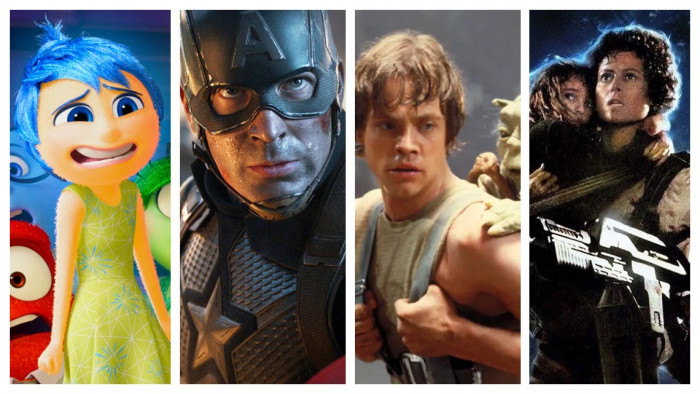The much-maligned 'Waterworld' is now on Netflix - this is why it's worth a reappraisal
"Dry land is NOT a myth!"


Nobody expected Titanicto be good. Its lengthy, expensive production was constantly snarked at in the press, with journalists gleefully jumping on every bit of bad news that came from the set, giggling at this ridiculously expensive folly that was clearly doomed to fail.
Then it came out, made millions of people cry, became the first film to ever gross a billion dollars and won both Best Director and Best Picture at the Oscars. Everyone who’d spent the production process sniggering at what a failure it was going to be looked cynical and silly.
The thing is, they’d had plenty of practice two years earlier, savaging Waterworld all the way through its troubled production. Long before the film came anywhere near cinemas, it had been happily dismissed as a flop, a cash-haemorrhaging disaster, a career-ending bit of celluloid hubris from an out-of-control ego. When it came out, it eventually broke even, but its name was, just like the mulch the atoll-dwellers in it sink dead bodied into, mud.
Waterworld is not a perfect film by any stretch, but it’s a lot of fun, and far better than its unwarranted reputation as a cock-up would suggest. It’s a visually stunning B-movie with an A-movie budget, a hugely impressive project cursed by context. Take the film out of the 1990s - as its new arrival on Netflix lets us do - and it’s a totally entertaining, original piece of action cinema.
As a Mad Max-esque post-apocalyptic explosion-filled romp (Outlaw Vern, the internet’s best film writer, dubbed Costner’s character “Wet Max”), it’s great, and far more entertaining than the world wanted it to be.
Why did everyone want Waterworld to fail, and rub their hands delightedly every time something went wrong with it?
Kevin Costner, is why.
Costner had gone from obscurity to A-lister in a really short amount of time. 1985’s Silverado was his first substantial film role, he was headlining films two years later, and two years after that he was the star and director of Dances With Wolves, winning both the Best Picture and Best Director gongs at the 1990 Oscars. With this success came a bit of a backlash - Costner’s acting (or lack thereof) in Robin Hood: Prince Of Thieves was not received well by critics, and his limited range (which had served him well playing characters like The Untouchables’ buttoned-down Elliott Ness) began to seem a bit tiresome. Was there really anything to him, or was he just lucky and handsome enough to make it?
And everything coming out about Waterworld suggested overkill. It was greenlit at a budget of $100m, equal to the previous year’s True Lies, a sum that had seemed unthinkable. Ultimately, the later film ended up costing nearly double that amount - the official figure given is $172 million, but the real figure is thought to be closer to $200 million.
Reports came out of Costner’s reportedly out-of-control ego taking over, wresting control from Prince Of Thieves director Kevin Reynolds, who later said, gloriously bitchily, in an interview that “In the future Costner should only appear in pictures he directs himself. That way he can always be working with his favorite actor and his favorite director.”
Joss Whedon, later to create Buffy The Vampire Slayer and write and direct Avengers Assemble, described his time spent on-set doing emergency script doctoring as “seven weeks of hell”. He later said “I was there basically taking notes from Costner, who was very nice, fine to work with, but he was not a writer. I accomplished nothing. I wrote a few puns, and a few scenes that I can’t even sit through because they came out so bad.”

Kevin Costner: this dude has gills
Every story that came off the set was gleefully leapt on. Costner and co-stars Jeanne Tripplehorn and Tina Majorino all had incidents where they fell off boats and had to be rescued. Costner’s stunt double was washed out to sea. Several extras fell off sets and had to be saved.
“A stunt man commuting to the set by jetski ran out of gas and was fifty miles out to sea by the time the Coast Guard picked him up” recalls Costner’s then-agent Michael Ovitz in his 2018 autobiography. This was all happily devoured by the press at the time, who nicknamed the film “Kevin’s Gate” and “Fishtar”, after the high-profile flops Heaven’s Gate and Ishtar.
The bad press clouded around the project like, to use an appropriately water-based simile, that stuff that supposedly makes swimming pools turn purple if you wee in them. Costner reportedly stayed in an extortionately expensive, impossibly luxurious beachfront villa during production while crew stayed in bare-bones no-frills accommodation, growing to hate their star. There were tales of crew members taking particular glee in throwing buckets of water into Costner’s face to maintain his perma-wet look between takes, and unsubstantiated rumours that he was demanding that his receding hairline be fixed in post-production using then-pioneering expensive digital technology.
This all made the film impossible to watch on its own merits - it couldn’t exist outside of its own larger narrative. You couldn’t just watch the story of The Mariner, a be-gilled loner in a post-apocalyptic flooded world, you had to watch Arrogant Movie Star Kevin Costner as The Mariner in A Poorly Thought-Through Folly, What An Idiot.
Roger Ebert’s review of the film, like most of them, begins with a gag about the budget: “In the old days in Hollywood, they used to brag about how much a movie cost. Now they apologize. There’s been so much publicity about this movie’s budget that a review of the story seems beside the point; I should just print the spreadsheets.”

We’ve all been there
Adjusted for inflation and seen from 2018, it’s at the barely remarkable number 11 on a list of the most expensive films ever made. Films like John Carter, Spider-Man 3 and the third and fourth Pirates Of The Caribbean movies all cost more but don’t have the same reputation, plus were all based on pre-existing properties. Now that, 23 years after Waterworld’s release, we can watch it on Netflix without having to get up, it can exist outside of its money-based meta-narrative and be enjoyed in it own terms. and there’s plenty to enjoy.
The world built for the film is amazing. People love getting excited by practical effects these days - it’s seen as being more legitimate, more creative, more legit, to build things in order jump off them, blow them up or smash them over people’s heads than to construct everything digitally. A large part of the criticisms that are generally levelled at action-packed major releases now is that they inevitably descend into identikit CGI-filled climaxes, disparate elements digitally composited together into some semblance of a battle, all taking place in a landscape that exists only as a collection of ones and zeroes.
If Waterworld was made now, the practical side of it would be hailed as incredibly impressive. Huge floating sets were constructed at massive cost, including a giant atoll, a huge part of which ended up sinking. A huge transforming trimaran, a reconstruction of the Exxon Valdez, big silly hot-air balloons, bungee jumps, zipwires, awesome surfing stunts - it’s badass. There’s a Waterworld stunt show that still runs at Universal Studios in Hollywood, Japan and Singapore, because massive fights on water are just hella cool.
The late, great Dennis Hopper was in the scenery-chewing don’t-give-a-shit period of his career by this point - he did this, Speed and Super Mario Bros. over a three-year period, shouting his way into a comfy retirement. Speed is, obviously, one of the greatest action movies ever made, but Hopper’s output at the time suggests he’d have given exactly the same performance if it was a straight-to-VHS Van Damme picture. In Waterworld, as the growling, despotic Deacon, he’s at his f*ck-this-pay-me best, bringing the sort of big-ass panto-style performance that makes Daniel Day-Lewis in There Will Be Blood seem phoned in.
Kevin Costner, playing opposite him, is not funny, and has never been funny, and that’s perfect for this: if the hero employed even a modicum of the hammy no-holds-barred zaniness of Hopper’s villain, the film would feel like it was insulting the viewer. His woodenness suits his monosyllabic loner perfectly. Elsewhere, there’s a pre-fame Jack Black giving us an early taste of his larger-than-life screen presence, the sadly departed character actor Michael Jeter playing a Michael Jeter role, and a tiny little old man in an oil tanker who haunts some viewers to this day and inspired a scene in Spaced. (Jeanne Tripplehorn, who is a great actor, is given nothing to work with at all, and Tina Majorino later turned out to be really good in Napoleon Dynamite but is genuinely irritating in this - not through any fault of her own, she’s ten years old and her role is crap.)

Rein it in mate
One of the best things about the movie, the most punk-rock way of starting a film ever, is also probably at least slightly responsible for turning people off: Kevin Costner is introduced drinking his own piss. Film critic Nathan Rabin later wrote: “It’s possible that there are more off-putting ways to introduce the hero of a giant would-be blockbuster, but until some Costner-level auteur of the future develops the testicular fortitude to introduce a hero raping a nun, defecating on an American flag, or attending to painful hemorrhoids, Waterworld’s record for queasiest introduction of a stoic hero appears secure.”
He’s wrong - it’s amazing, he drinks piss. An actor whose main appeal is his all-American handsomeness is in a film where he has gills and webbed feet and drinks piss, it is mad, it is amazing.
The 1990s were the early days of the internet, where pedants were first discovering the joys of coming together to tear things to shreds, and various ridiculous plot points were deconstructed on slow-loading message boards. Machines in the film run on crude oil, which nothing could run on. The baddies all constantly smoke cigarettes left over from current times, which would have long ago decomposed. They do this while living in a world where paper is invaluable and sought after, it never occurring to anyone that that’s what fags are made of. And, most dramatically of all, if all the ice in the sea melted, sea levels would only rise by a few hundred feet - enough to irreversibly change life on Earth, certainly, but there’d still be an awful lot of land, and the idea that the world would forget there was ever anything other than ocean is kind of lunacy (in the film, the only dry land is the top of Mount Everest).
But does that matter in a world where the characters of the X-Menfilms age two years every decade, where highbrow SF like Sunshine completely ignores the concept of gravity because it’s fiddly to work out, where the Marvel Cinematic Universe writes and rewrites the rules of reality whenever it fancies? The MCU has magic, Valhalla and time travel in it and we eat that up with a spoon, but a film where there’s slightly deeper water than there would be in real life is too much for people?

Waterworld: arguably a film that could benefit from some hair product
Look, Waterworld isn’t the best film in the world. There are a hundred better films on Netflix. But it’s its own thing, an original, self-contained, ambitious, action-packed adventure with some really fun sci-fi ideas, a great bit of opening narration, a beautifully unhinged villain, a terrific score by James Newton Howard and lots of big stuff falling over.
It’s seen as a bit of a punchline, shorthand for the kind of failure you can get when someone gets too big for their boots, but seen just as what it is, it’s a big silly laugh, and the more films like it, the better.
And can Jim Carrey in The Cable Guy be wrong?
DRY LAND IS NOT A MYTH!
(Images: Getty)
Latest
Related Reviews and Shortlists


The 10 best war movies of the 21st century








